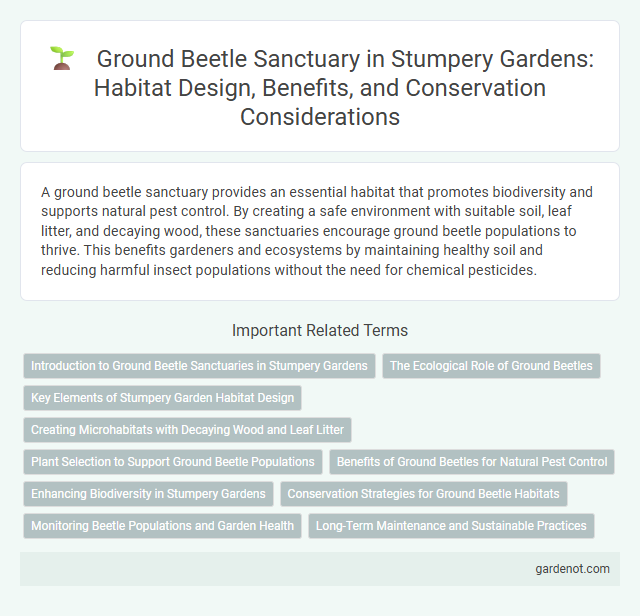A ground beetle sanctuary provides an essential habitat that promotes biodiversity and supports natural pest control. By creating a safe environment with suitable soil, leaf litter, and decaying wood, these sanctuaries encourage ground beetle populations to thrive. This benefits gardeners and ecosystems by maintaining healthy soil and reducing harmful insect populations without the need for chemical pesticides.
Introduction to Ground Beetle Sanctuaries in Stumpery Gardens
Ground beetle sanctuaries in stumpery gardens provide essential habitats that support biodiversity by offering shelter and breeding grounds for various Carabidae species. These sanctuaries utilize decaying wood and leaf litter, creating microhabitats favorable for ground beetles, which contribute to natural pest control by preying on slugs, aphids, and other garden pests. By fostering such environments, stumpery gardens enhance ecological balance while promoting sustainable gardening practices.
The Ecological Role of Ground Beetles
Ground beetles play a crucial ecological role by controlling pest populations and maintaining soil health within a stumpery ecosystem. Their predatory behavior helps reduce harmful insects, promoting plant growth and biodiversity. By burrowing, these beetles aerate the soil, enhancing nutrient cycling and supporting the stumpery's overall environment.
Key Elements of Stumpery Garden Habitat Design
The Ground beetle sanctuary in a stumpery garden hinges on integrating decaying wood piles and shaded, moist microhabitats to replicate natural woodland conditions crucial for Carabidae species. Strategic placement of logs and stones creates refuge and hunting grounds, supporting biodiversity and soil health. Incorporating native plants alongside stumps enhances habitat complexity, fostering a sustainable ecosystem for ground beetles.
Creating Microhabitats with Decaying Wood and Leaf Litter
Creating microhabitats with decaying wood and leaf litter in a stumpery provides ideal conditions for ground beetle sanctuaries by offering shelter, moisture, and abundant prey. These natural elements support beetle biodiversity by mimicking their preferred habitats, promoting breeding and foraging activities. Maintaining layered, decomposing organic matter enhances soil health while sustaining the complex ecosystem necessary for ground beetle populations.
Plant Selection to Support Ground Beetle Populations
Choosing native ferns, mosses, and shade-tolerant shrubs creates an ideal habitat for ground beetles by providing moisture retention and shelter. Incorporating decaying logs and leaf litter within the stumpery enhances biodiversity by offering critical cover and breeding sites. Selecting plants that support a rich insect fauna ensures a sustainable food source for ground beetle populations, fostering a balanced ecosystem.
Benefits of Ground Beetles for Natural Pest Control
Ground beetle sanctuaries play a crucial role in natural pest control by providing habitats that support diverse populations of these predatory insects. Ground beetles consume a wide range of agricultural pests, including caterpillars, aphids, and slugs, reducing the need for chemical pesticides. Promoting ground beetle habitats within stumperies enhances ecosystem balance and supports sustainable garden and farm management practices.
Enhancing Biodiversity in Stumpery Gardens
Ground beetle sanctuaries within stumpery gardens provide essential habitats that boost local biodiversity by supporting diverse beetle species crucial for natural pest control. Incorporating decaying wood and leaf litter creates microhabitats that sustain ground beetle populations, enhancing soil health and ecological balance. These sanctuaries contribute to a resilient garden ecosystem by fostering predator-prey relationships and nutrient cycling, vital for sustainable horticulture.
Conservation Strategies for Ground Beetle Habitats
Stumperies provide essential microhabitats that support the conservation of ground beetle populations by maintaining moisture, shelter, and food sources. Strategic placement of decaying wood and leaf litter in stumperies enhances habitat complexity, promoting beetle biodiversity and resilience. Monitoring soil conditions and controlling invasive species within these sanctuaries ensure optimal environments crucial for ground beetle survival and reproduction.
Monitoring Beetle Populations and Garden Health
Monitoring beetle populations within a stumpery-based Ground beetle sanctuary involves regular assessment of species diversity and abundance using pitfall traps and visual surveys. Data collected provides critical insights into ecosystem health, indicating soil quality and pest control effectiveness in the garden environment. Maintaining optimal habitat conditions, such as moisture and decaying wood, supports robust beetle communities essential for garden pest management and biodiversity conservation.
Long-Term Maintenance and Sustainable Practices
Long-term maintenance of a ground beetle sanctuary within a stumpery involves preserving decaying wood habitats and ensuring continuous moisture levels to support beetle populations. Sustainable practices include minimal disturbance of soil, planting native flora to enhance biodiversity, and monitoring beetle species diversity regularly. These strategies promote ecological stability and provide a resilient habitat for ground beetles over time.
Ground beetle sanctuary Infographic

 gardenot.com
gardenot.com